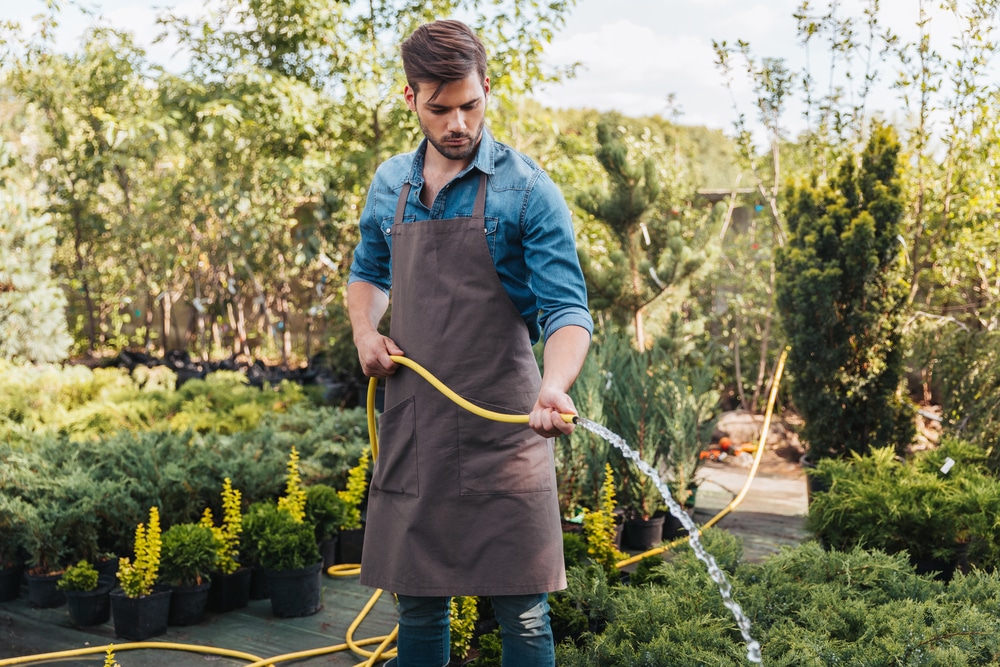Last Updated on
Water is vital for all living things and promotes healthy growth in plants. While some plants might exhibit dehydration signs when they don’t get enough water, some plants might not show very obvious signs, which is why it’s a good idea to read up on each plant’s needs, as well as keep a watering schedule.
If plants don’t get enough water regularly, they may get sick and eventually may die. To stop this from happening, you have to water plants regularly at a specific time frame. In this post, we will walk you through when to water plants to get effective results.
Best Time to Water Plants
Morning Watering for Growing a Healthy Root System
An ideal time to water plants by using a garden hose (container plants, hedges and shrubs) is in the morning. Water seeps through the soil surface easily to hydrate a wide array of plants during the early morning hours. Not to mention, the sunshine intensity may not be too strong to cause evaporation or burn their leaves.

Watering your plants early in the morning increases the overall moisture content around the root zone, making it easier for plants to withstand harsh weather conditions.
It is a good idea to be aware of the sunlight’s intensity as it varies during the day, depending on the position of the sun and the season. For instance, sunlight rays are quite harsh at noon, causing excess water evaporation due to hot weather conditions, especially in the summer. Furthermore, any water droplets that stay on the plant’s leaves could be magnified by the sun’s rays causing the leaves to burn.
Due to this, noon is not the most suitable time for watering your garden plants or any plants that sit in direct sunlight. Additionally, more water might be used to water plants when the sunlight intensity is high.
Evening Watering to Ensure Healthy Growth
If your mornings are preoccupied with different tasks and activities, you should water the plants a few hours before sunset, when the sunlight’s intensity has decreased but it’s not yet too cold.
Ensure that the water has enough time to seep into the garden soil before the sun sets completely. If water doesn’t seep into the soil before the sun sets, it might promote the growth of fungi, and a high level of soil moisture may attract various types of insects, which might feed on your plants. Additionally, it might affect the foliage, causing various disease problems.
Due to this, we recommend that you water your garden plants a few hours before the sun sets, giving them enough time to absorb the water completely.
Watering Plants
Different plants need varying quantities of water, depending on their characteristics. While some plants might require large quantities of water, some can survive for a long period without water.
Various plant watering techniques, such as drip irrigation, can help you water plants regularly, especially if you are watering vegetables or watering flowers. Such techniques can keep the soil wet for longer, nourishing a plant from the roots. Furthermore, you don’t run the risk of water evaporating or creating droplets on the plant’s leaves that could burn the foliage.
Perennial Plants and Annual Plants
As plants have different characteristics and properties, they require different amounts of water. Most plants can be either categorised as perennial plants or annual plants. Perennial plants are plants that can grow for many seasons without dying. Annual plants, as the name hints, go through their entire life cycle within one year. Annual plants have to be watered regularly as compared to perennial plants. It is because the roots of annual plants do not grow deep in the soil. Perrenial roots, on the other hand, penetrate deep into the soil and can access groundwater.
Watering Your Plants
The best time when to water plants can be some hours before sunset or in the morning, as the sunlight intensity during such periods is not too harsh. It can be said for most plants, whether they are indoor or outdoor plants or annuals or perennials.
It’s always best to research the plants you are trying to grow to know whether they like dry soil and go for a few days or weeks without being watered.
Ian loves everything that revolves around the home improvement niche. He loves trying out new home appliances. He has also handled a lot of equipment and has a lot of insight. Plus, he’s worked on various home improvement projects that became a success.
If Ian isn’t busy working on his latest project, you can find him reading up about another one!



